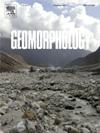Assessing the morphological alteration of river reaches from 15 years of measurements: French hydromorphological database and indicators (Carhyce)
IF 3.1
2区 地球科学
Q2 GEOGRAPHY, PHYSICAL
引用次数: 0
Abstract
To improve fresh water ecological quality, river managers have to assess the geomorphological functioning of the river system and sometimes restore it. Despite noticeable efforts made in recent years by the geomorphological community, hydro-morphological assessment methods and tools are still called for and needed. In France, river managers may rely on the Carhyce catalogue built by the French Biodiversity Agency and its partners over 15 years. This is a unique database allowing the characterization of the hydromorphology of French rivers. It is based on a standardized field protocol that entails a survey of the bankfull geometry of a reach 14 times the length of the river width. To date, >2500 river reaches of all type of rivers present on the French territory have been surveyed and the related data are freely available via a web interface, where they have been formatted and presented in the form of tables, graphs, sketches and indices. In addition, a morphological index has been produced to help identify and measure potential alterations of the physical functioning of the reaches. To do so >500 reaches have been identified as references to build reach average hydraulic geometry relationships. Those reference models allow the morphological deviation from the regional reference situation to be determined. This paper presents the Carhyce catalogue and the Global Morphological Index (GMI), as well as several examples of how it may be used. The limits and benefits of the Carhyce data are discussed and the GMI is compared to a well-use index of morphological quality.
求助全文
约1分钟内获得全文
求助全文
来源期刊

Geomorphology
地学-地球科学综合
CiteScore
8.00
自引率
10.30%
发文量
309
审稿时长
3.4 months
期刊介绍:
Our journal''s scope includes geomorphic themes of: tectonics and regional structure; glacial processes and landforms; fluvial sequences, Quaternary environmental change and dating; fluvial processes and landforms; mass movement, slopes and periglacial processes; hillslopes and soil erosion; weathering, karst and soils; aeolian processes and landforms, coastal dunes and arid environments; coastal and marine processes, estuaries and lakes; modelling, theoretical and quantitative geomorphology; DEM, GIS and remote sensing methods and applications; hazards, applied and planetary geomorphology; and volcanics.
 求助内容:
求助内容: 应助结果提醒方式:
应助结果提醒方式:


